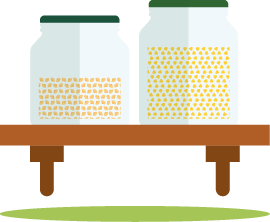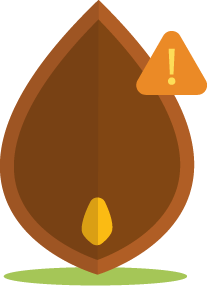
Millets are a group of whole grain cereals with a buttery flavour. Millets include a wide range of cereals that produce small grains (seeds) from a naturally diverse set of grass species. Millets include pearl, proso, foxtail, barnyard, little, kodo, browntop, finger and guinea millets, as well as black and white fonio, sorghum, teff and Job’s tears, and many other diverse and local species. Millets are found in many diets around the world, but they particularly form an integral part of traditional Indian and sub-Saharan African cuisines.
Millets can be cooked in a variety of ways. Depending on how much liquid is used, they can be prepared fluffy for pilafs and grain salads, sticky for croquettes and patties, or creamy for warm porridge. Millets can also be ground and used as flour (as in Indian roti, a type of flatbread) or prepared similar to maize polenta.
Millets pair well with mushrooms, herbs, warm spices, scallions/spring onions, and squash.
2023 was named the International Year of Millets by the Food and Agriculture Organization of the United Nations due to its many benefits.

Millets provide a wide array of nutrients. They are high in phosphorus, iron, and copper. They’re also a source of fibre, magnesium, zinc, and thiamine (vitamin B1).
Millets are gluten-free.

Toggle with the tables below to compare their nutritional content per 100 g (both cooked and uncooked) and per average portion size. You might be surprised by the differences!
| Grains | Kcal | Protein | Fat | Saturated fat | Carbohydrates | Fibre |
|---|---|---|---|---|---|---|
| Millet, Per 100 g, cooked | 123.00 | 3 | 1 | 0 | 23 | 1 |
| Millet, Per 100 g, uncooked | 370.00 | 11 | 4 | 0 | 71 | 3 |
Whole grains are all packed with carbohydrates and dietary fibre (which is a type of carbohydrate) and are naturally low in (saturated) fat. Fibre is important for our health and the prevention of many chronic diseases. That’s why the European Food Safety Authority (EFSA) recommends we eat at least 25 g of fibre per day. Sometimes, you might see whole grains labelled as ‘high in fibre’ or ‘source of fibre’ – but what does that really mean?
| Grains (% of DRV) | Calcium | Magnesium | Phosphorus | Potassium | Iron | Zinc | Copper | Vit. B1 | Vit. B2 | Vit. B3 | Vit. B6 | Folate |
|---|---|---|---|---|---|---|---|---|---|---|---|---|
| Millet, per 100 g, cooked | 1.50 | 9.07 | 13.43 | 5.00 | 11.43 | 5.70 | 17.00 | 8.18 | 3.57 | 3.75 | 0.00 | 3.03 |
| Millet, per 100 g, uncooked | 3.13 | 26.67 | 42.86 | 14.00 | 34.29 | 17.00 | 49.00 | 23.64 | 10.00 | 11.25 | 0.00 | 9.09 |
| Millet, per portion, cooked | 1.05 | 6.35 | 9.40 | 3.50 | 8.00 | 3.99 | 11.90 | 5.73 | 2.50 | 2.63 | 0.00 | 2.12 |
| Millet, per portion, uncooked | 2.19 | 18.67 | 30.00 | 9.80 | 24.00 | 11.90 | 34.30 | 16.55 | 7.00 | 7.88 | 0.00 | 6.36 |
% of DRV stands for dietary reference value. DRV stands for dietary reference value. These values estimate how much of a nutrient most healthy people in Europe need each day. Ideally, we should aim to reach 100% of these values daily. Each vitamin and mineral has their own DRV, as set by EFSA.
You might have heard that whole grains are ‘high in,’ ‘rich in,’ or ‘source of’ a certain vitamin or mineral. These term are regulated by EFSA and products must meet specific rules to be considered as such. Here’s how to interpret these contributions:

Store in an airtight container in a cool, dry place. Follow the instructions on the packaging to keep the food good for as long as possible.
Millets have a best-before date, meaning that it can often be eaten after that date has passed. If it looks, smell and tastes good, and the packaging is also intact, it will most likely be safe.

Follow the instructions on the packaging to cook millet. Cooking times can vary depending on the variety and type of millet.
As a general rule of thumb, use a ratio of 1 part of millets to 2 ½ parts of water. Bring to boil, then simmer 25-35 minutes until tender.

When you see millet on an ingredient list, you can almost always be sure it is whole millet, and is a whole grain.
Learn to identify whole grain products, cook delicious meals, find practical tips for a smooth, gradual switch, and much more!